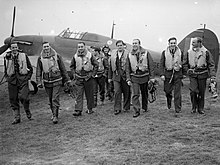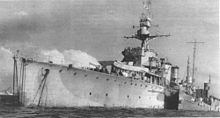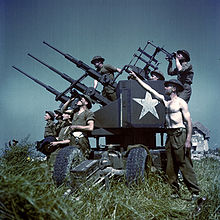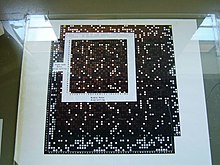| Polish contribution to World War II | |
|---|---|
 Pilots of the No. 303 Squadron, from left: P/O Ferić, Flt Lt Kent, F/O Grzeszczak, P/O Radomski, P/O Zumbach, P/O Łokuciewski, F/O Henneberg, Sgt. Rogowski, Sgt. Szaposznikow | |
 One of the four Polish Enigma doubles assembled eight years after Poland was first to crack the German machine, in 1932 | |
 ORP Dragon, in Polish Navy service from January 1943 | |
 | |
 Anti-aircraft mounting with three Polish Polsten cannons | |
 Crew of submarine ORP Sokół with Jolly Roger marking number of sunk or damaged enemy ships | |
 Demonstration of Zygalski sheets (perforated sheets) |
In World War II, the Polish armed forces were the fourth largest Allied forces in Europe, after those of the Soviet Union, United States, and Britain.[a][1][2][3][4][5][6][7] Poles made substantial contributions to the Allied effort throughout the war, fighting on land, sea, and in the air.
Polish forces in the east, fighting alongside the Red army and under Soviet high command, took part in the Soviet offensives across Belarus and Ukraine into Poland and across the Vistula and Oder Rivers to the Battle of Berlin.
In the west, Polish paratroopers from the 1st Independent Polish Parachute Brigade fought in the Battle of Arnhem / Operation Market Garden;[8] while ground troops were present in the North Africa Campaign (siege of Tobruk); the Italian campaign (including the capture of the monastery hill at the Battle of Monte Cassino); and in battles following the invasion of France (the battle of the Falaise pocket; and an armored division in the Western Allied invasion of Germany).
Particularly well-documented was the service of 145 Polish pilots flying British planes under British Command during the Battle of Britain, 79 in mixed squadrons under the RAF after July 1940, 32 in wholly Polish Squadron 303 after 31 August 1940 and 34 in entirely Polish Squadron 302.[9] Other instances of service flying French planes[clarification needed] in the Polish Air Force took place during the Battle of Britain at the same time, and from 1944 the Polish Air Force (also with British planes) was established in Britain.
Some Polish contributions were less visible, notably the prewar and wartime decrypting of German Enigma-machine ciphers by cryptologists Marian Rejewski, Henryk Zygalski, and Jerzy Różycki. An extensive Polish intelligence network also proved of great value to Allied intelligence.
The European Theatre of World War II opened with the German invasion of Poland on Friday September 1, 1939, followed by the Soviet invasion of Poland on September 17, 1939. On 6 October, following the Polish defeat at the Battle of Kock, German and Soviet forces gained full control over Poland. The success of the invasion marked the end of the Second Polish Republic, though Poland never formally surrendered. A Polish Underground State with a government-in-exile that would eventually set up headquarters in London resumed the struggle against the occupying powers. The Polish forces in the West, as well as in the East and an intelligence service were established outside of Poland, and contributed to the Allied effort throughout the war.
- ^ Walters, E. Garrison (1988-06-01). The Other Europe: Eastern Europe to 1945. Syracuse University Press. p. 276. ISBN 978-0-8156-2440-0.
Poland had the fourth largest Allied army in the war (after the USSR , the U.S. , and Britain)
- ^ Crampton, Richard; Crampton, Benjamin (2016-06-11). Atlas of Eastern Europe in the Twentieth Century. Routledge. p. 1950. ISBN 978-1-317-79951-1.
Inside Poland there were large resistance forces, the Polish Home Army (AK) being the fourth largest fighting force on the allied side, ranking behind the Soviet, American and British but before the French.
{{cite book}}: CS1 maint: date and year (link) - ^ Bajda, Andrew (2021-03-25). Captured in Liberation. Page Publishing Inc. ISBN 978-1-68409-043-3.
... the Polish Army made up the fourth largest fighting force among all Allied ...
- ^ Rosinski, Jan; Hile, Richard (2013-10-18). The Warsaw Underground: A Memoir of Resistance, 1939-1945. McFarland. p. 161. ISBN 978-0-7864-7693-0.
... veterans of the Polish army, air force, and navy—in total the fourth largest manpower contribution to the Allied war ...
- ^ Crampton, R. J. (2002-04-12). Eastern Europe in the Twentieth Century – And After. Routledge. p. 198. ISBN 978-1-134-71221-2.
...making it the fourth largest of the allied armies after the Soviet, American, ...
- ^ Paul, Allen (2010-03-15). Katyn: Stalin's Massacre and the Triumph of Truth. Cornell University Press. p. 343. ISBN 978-1-5017-5720-4.
.. Polish forces constituted the fourth largest Allied army ..
- ^ Wiatr, Jerzy J. (2019-06-12). The Soldier And The Nation: The Role Of The Military In Polish Politics, 1918-1985. Routledge. ISBN 978-1-000-30559-3.
..it was then the fourth largest allied army in Europe (after the Soviet, U.S., and British armies).
- ^ Kinloch, Nicholas (2023). From the Soviet Gulag to Arnhem: A Polish Paratrooper's Epic Wartime Journey. Pen and Sword. ISBN 978-1399045919.
- ^ Gasior, Mariusz. "The Polish Pilots Who Flew In The Battle Of Britain". Imperial War Museum.